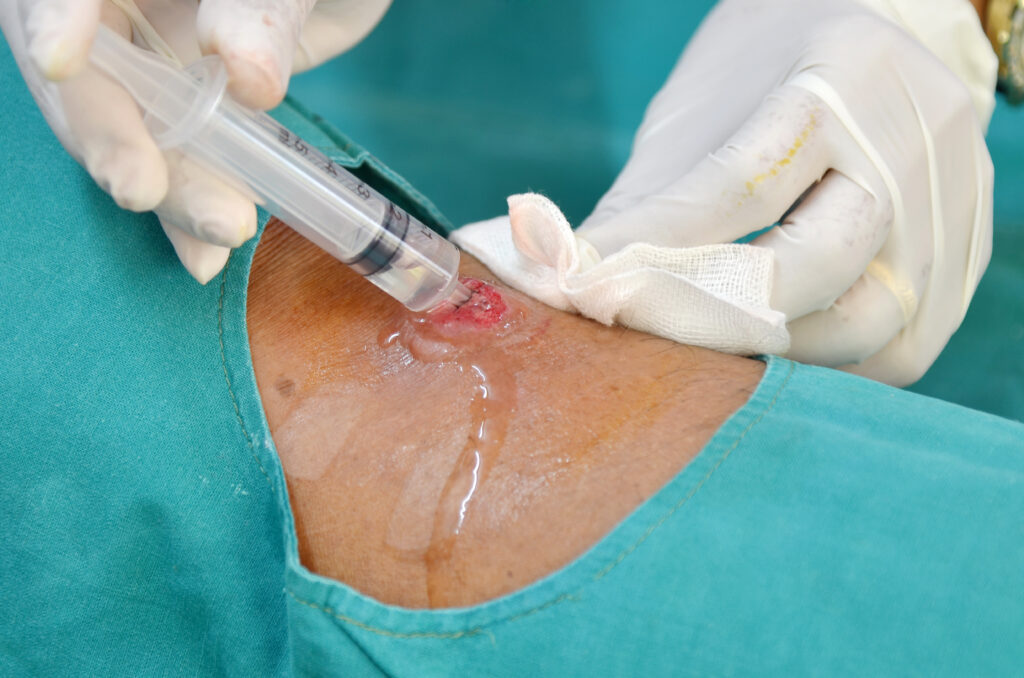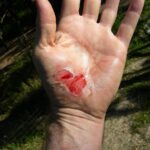Wound irrigation is a fundamental aspect of wound management involving the controlled application of fluid to cleanse and remove exudates, foreign material, bacteria, and cellular debris. Effective irrigation reduces the risk of infection, supports the healing process, and improves overall wound outcomes. It is especially critical in managing acute traumatic injuries, surgical sites, chronic ulcers, and burns.

Objectives and Benefits of Wound Irrigation
Wound irrigation serves several essential functions:
- Reduces bacterial load and biofilm formation
- Removes debris and necrotic tissue
- Prepares the wound bed for advanced therapies and dressing
- Minimizes pain and mechanical trauma compared to scrubbing
- Enhances healing outcomes and decreases complications
Indications and Contraindications
Indications:
- Contaminated or dirty wounds
- Open surgical incisions
- Pressure ulcers, diabetic foot ulcers, and leg ulcers
- Burns or chemical injuries
- Traumatic lacerations or punctures
Contraindications:
- Closed wounds with intact skin
- Deep fistulae or sinus tracts without visualization
- Where excessive irrigation pressure may cause tissue damage
Classification of Wound Irrigation Techniques
1. Manual Irrigation
- Performed using a syringe (commonly 35 mL) with an attached 19-gauge catheter
- Delivers irrigation at safe pressures (4–15 psi)
- Ideal for small to moderate wounds
2. Pressurized Irrigation
- Utilizes specially designed irrigation devices or bottle systems
- Ensures consistent pressure and flow rate
- Useful for large or deep wounds
3. Pulsatile Lavage
- Mechanized irrigation that combines pulsing fluid delivery with suction
- Reduces bacterial biofilm more effectively
- Often used in surgical and chronic wound care settings
4. Soaking / Bathe Irrigation
- Immersion of a wound in a solution
- Used in burns or wounds with extensive surface area
Choosing the Right Irrigation Solution
Sterile Saline Solution (0.9% NaCl)
- Gold standard for general wound cleansing
- Isotonic, non-toxic, and well-tolerated by all tissue types
Sterile Water
- Used when saline is unavailable
- Hypotonic, may cause cell lysis if overused
Antiseptic Solutions
- Povidone-iodine: Effective antimicrobial, may be cytotoxic
- Chlorhexidine: Broad-spectrum activity; use with caution in open wounds
- Hydrogen peroxide: Reserved for heavily contaminated wounds; avoid deep tissue contact
Surfactant-based Irrigants
- Contain agents that break down biofilm and organic debris
- Frequently used in infected or chronic wounds
Antibiotic Solutions
- Reserved for infected wounds with confirmed pathogen sensitivity
- Not used routinely due to resistance concerns
Optimal Irrigation Pressure and Volume
Maintaining correct pressure is vital to avoid tissue damage and ensure thorough cleansing:
- 4–15 psi is the safe and effective range
- <4 psi may be ineffective in removing debris
- 15 psi may damage viable tissue and force bacteria deeper
The volume of solution used depends on wound size and contamination level. In trauma or contaminated wounds, irrigation with 500–1000 mL or more may be necessary.
Wound Irrigation Equipment and Supplies
- 35 mL syringe with 19-gauge catheter
- Irrigation tip devices
- Saline or prescribed solution
- Sterile gloves and drapes
- Basin or absorbent pads
- PPE (personal protective equipment)
Step-by-Step Wound Irrigation Procedure
- Preparation
- Perform hand hygiene and don gloves
- Gather supplies and explain the procedure to the patient
- Positioning
- Ensure patient comfort and expose the wound site
- Place waterproof drapes or pads beneath the wound
- Irrigation
- Use appropriate solution and device
- Direct flow from clean to dirty area, avoiding tissue trauma
- Collect runoff safely to prevent contamination
- Post-Irrigation Care
- Gently pat surrounding skin dry
- Apply appropriate wound dressing
- Document the procedure, solution used, volume, and patient response
Infection Control Considerations
- Always use sterile techniques and solutions in acute or surgical wounds
- Use personal protective equipment to prevent splash contamination
- Avoid cross-contamination between wounds or patients
- Discard all single-use devices appropriately
Special Considerations in Chronic Wounds
Chronic wounds, such as diabetic ulcers and venous leg ulcers, often harbor biofilms resistant to conventional irrigation. In these cases:
- Use antimicrobial or surfactant-based solutions
- Consider pulsatile lavage or ultrasonic debridement
- Repeat irrigation regularly as part of comprehensive wound care protocols
Common Mistakes to Avoid
- Using high-pressure jets that damage tissue
- Irrigating with contaminated or expired solutions
- Overuse of cytotoxic antiseptics
- Inadequate volume leading to insufficient cleansing
- Irrigation without assessing wound depth or structure
Advancements in Wound Irrigation Technology
Innovative technologies are enhancing irrigation effectiveness:
- Smart irrigation systems that regulate pressure and flow
- Single-use disposable wound irrigation kits
- Automated negative pressure wound therapy with instillation (NPWTi)
- Ultrasound-assisted irrigation for deep wound cleansing
These methods improve precision, reduce infection rates, and support faster recovery.
Frequently Asked Questions:
Q1: Why is wound irrigation important?
It prevents infection, removes contaminants, and supports healthy tissue regeneration.
Q2: What is the best solution for wound irrigation?
Sterile normal saline is the most commonly recommended solution due to its safety and efficacy.
Q3: Can I use tap water for irrigation?
Tap water may be used in low-risk, superficial wounds when sterile solutions are unavailable, provided the water quality is safe.
Q4: How often should a wound be irrigated?
As prescribed by clinical guidelines—typically during dressing changes or when contamination is evident.
Q5: Is antiseptic irrigation safe for all wounds?
No. Some antiseptics can delay healing; their use should be limited to infected or high-risk wounds under medical supervision.
Wound irrigation remains a cornerstone of effective wound care. By selecting appropriate solutions, techniques, and equipment, we can ensure optimal wound cleansing, reduce infection risk, and promote faster healing. The integration of evidence-based practices with evolving technologies will continue to enhance patient outcomes in both acute and chronic wound settings.

